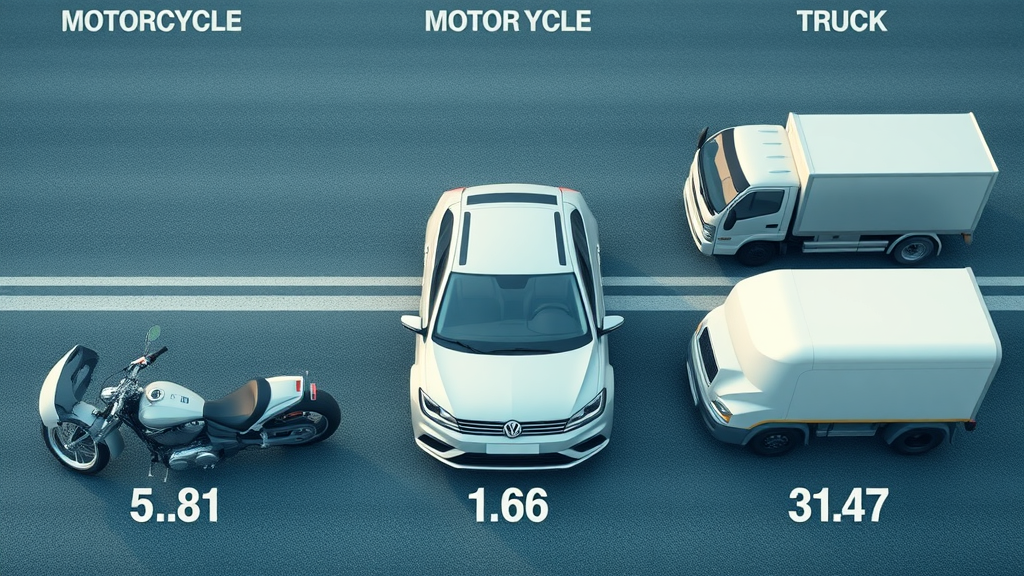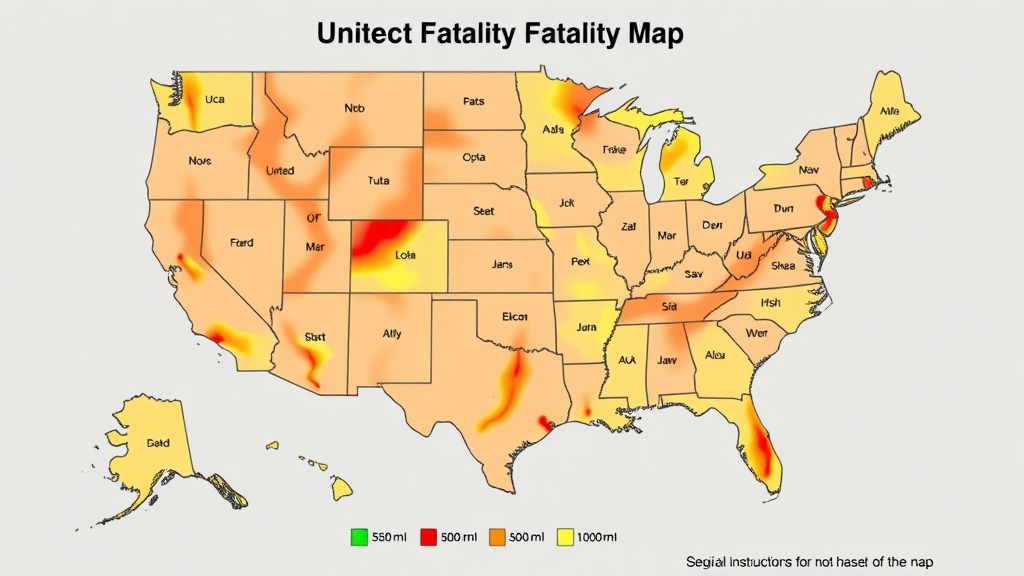Imagine being 28 times more likely to die in a traffic crash just because of your mode of transport. This is the harsh reality facing motorcycle riders across the United States, where the statistics paint a sobering picture of risk, tragedy, and the urgent need for improved motorcycle safety. Motorcycles offer a thrilling ride, but they come with unique dangers—many of which are misunderstood or ignored. In this article, we pull back the curtain on the latest data, separating fact from fiction, and reveal what the numbers truly mean for every motorcycle rider and enthusiast. Prepare to be surprised—and informed—by the shocking truths that emerge from the heart of motorcycle crash statistics USA.
A Revealing Look at Motorcycle Crash Statistics USA: Shocking Truths and Key Data
- Did you know motorcyclists are 28 times more likely to die in a traffic crash than occupants of passenger vehicles in the United States?
- Explore the critical numbers and facts that shape motorcycle accident trends and outcomes.
- Discover actionable insights for motorcycle riders to enhance safety.

Key Takeaways from Motorcycle Crash Statistics USA: What You’ll Learn
- The most recent and relevant data on motorcycle accidents in the United States
- Which factors most contribute to fatal motorcycle crashes and motorcycle fatalities
- State-by-state breakdowns and comparison tables
- Motorcycle safety strategies to reduce accident and fatality rates
- Answers to the most frequently asked questions about motorcycle crash statistics USA
Motorcycle Crash Statistics USA: Overview of Recent Trends and Data
Motorcycle accident and motorcycle crash data highlights (2020-2024)
Motorcycle crash statistics USA reveal a consistent pattern of vulnerability for motorcycle riders over recent years. Between 2020 and 2024, national highway traffic safety data demonstrate that while motorcycles account for just 3% of all registered vehicles, they make up a much larger proportion of fatal crashes and traffic fatalities. Motor vehicle crash reports show that motorcycle accidents routinely result in a higher fatality rate than those involving passenger cars or trucks. In fact, recent estimates indicate that hundreds of thousands of motorcycle accidents occur annually across the country, many resulting in serious injury or death for the rider involved.
Motorcycle fatalities remain stubbornly high, despite advances in motorcycle safety equipment and awareness campaigns. The fatal motorcycle crash rate is far outpacing that of other motor vehicle categories, with estimates placing the fatality rate at 28 times higher per mile traveled compared to automobiles. These numbers highlight the particular risk factors facing motorcycle riders, who lack the protective shell of a car in the event of a fatal crash. Highlighting these disparities helps direct focus toward targeted interventions for improved highway traffic safety.

Fatal motorcycle crash and fatality rate: Comparing to other motor vehicle accidents in the United States
The risk of experiencing a fatal accident is dramatically greater for motorcycle riders compared to those in other vehicles. According to the National Highway Traffic Safety Administration (NHTSA), "motorcycle riders represent only 3% of registered vehicles but account for 14% of all traffic deaths in the USA." This means that even though motorcycles make up a relatively tiny fraction of all vehicles, they account for a disproportionately high number of fatal crashes. The fatality rate for motorcycles, when measured per 100 million miles traveled, greatly exceeds that of cars and trucks, making this demographic among the most at-risk groups on American roads.
"Motorcycle riders represent only 3% of registered vehicles but account for 14% of all traffic deaths in the USA." – NHTSA
| Year | Motorcycle Accidents | Motorcycle Fatalities | Fatality Rate (per 100M miles) |
|---|---|---|---|
| 2020 | 83,000 | 5,115 | 25.47 |
| 2021 | 85,500 | 5,511 | 27.61 |
| 2022 | 87,900 | 5,843 | 28.83 |
| 2023 | 86,300 | 5,522 | 27.12 |
| 2024 | Est. 88,200 | Est. 5,700 | Est. 28.2 |
Motorcycle Accident Hotspots: Where Do Most Motorcycle Accidents Happen in the USA?
Analysis of 70% accident locations: Intersections, highways, and urban vs. rural roads
Data from motorcycle crash statistics USA consistently show that approximately 70% of fatal motorcycle crashes take place at intersections or on busy urban roadways. The majority of these crashes are attributed to high-speed interactions, limited visibility, and dense traffic environments where passenger vehicles may not see a motorcycle rider in time to prevent a collision. Intersections in particular are highlighted as risk zones due to frequent turning maneuvers and sudden stops, increasing the risk of fatal accident scenarios for riders.
While urban areas see a high volume of motorcycle accidents, rural highways remain disproportionately dangerous for fatal motorcycle crashes. On these long and exposed stretches of road, excessive speed, impaired visibility, and lack of nearby medical assistance can quickly turn a motorcycle accident into a fatal event. Highways and road segments with unclear signage or poor lighting also contribute to the elevated risk profile for riders in both urban and rural settings.

Registered motorcycles and accident distribution across states
The number of registered motorcycles varies greatly across the United States, impacting where motorcycle accidents and fatal crashes are most likely to occur. States with warmer climates, longer riding seasons, and a vibrant biker culture, such as Florida, California, and Texas, typically report the highest number of motorcycle registrations—and thus a higher raw number of motorcycle accidents. However, when assessed per capita or per mile traveled, some less populous states rank highest for fatal motorcycle crash rates, offering valuable insights for targeted interventions.
| State | Registered Motorcycles | Fatal Crashes | Percentage of Total US Motorcycle Accidents |
|---|---|---|---|
| California | 800,000 | 480 | 11% |
| Florida | 600,000 | 545 | 10% |
| Texas | 480,000 | 420 | 8% |
| Pennsylvania | 375,000 | 180 | 6% |
| Ohio | 365,000 | 110 | 5% |
Demographics of Motorcycle Riders and Their Impact on Motorcycle Crash Statistics USA
Age, gender, and experience factors in motorcycle accident risk
Understanding the demographics of motorcycle riders is essential for interpreting motorcycle crash statistics USA. Traditionally, young men have comprised the highest-risk group for fatal motorcycle crashes, but recent data reveal that older riders (over 40) now account for a growing percentage of motorcycle fatalities. This shift may stem from increased disposable income and an expanding interest in motorcycling among older age groups.
Gender remains a significant risk factor. Male riders dominate motorcycle accident statistics, involved in over 90% of fatal crashes, though female participation is rising and requires further study. Experience level is another critical factor; novice riders are much more likely to be involved in fatal accidents, often due to overconfidence or lack of formal safety training. Conversely, experienced riders may face unique risks, including complacency or riding under hazardous conditions more often.

The role of novice vs. experienced motorcycle riders in fatal crashes
Fatality rates are notably higher among new motorcycle riders, reinforcing the need for robust traffic safety education and skill development programs. Many fatal motorcycle accidents involve operators with less than six months of riding experience, often attributed to unfamiliarity with emergency maneuvers, inadequate anticipation of hazards, or misjudgment of speed. Novice riders may also be more vulnerable to risky behavior, such as not wearing helmets or failing to complete a motorcycle safety course.
While experienced riders typically exhibit better control and hazard perception, they are not immune to involvement in fatal crashes. In fact, long-time motorcycle riders may sometimes engage in riskier behavior due to overconfidence. The combination of experience with responsible habits, proper training, and continuous learning is the best recipe for reducing the number of fatal motorcycle crashes across all skill levels.
Leading Causes Behind Fatal Motorcycle Crashes in the United States
Top factors: Speeding, alcohol involvement, and helmet use
Among all causes of fatal motorcycle crashes in the United States, three risk factors stand out: speeding, alcohol or drug impairment, and insufficient helmet use. Speed continues to be a primary contributor to motorcycle accidents, as it reduces reaction time and makes it harder to avoid hazards. Alcohol involvement is present in nearly one-third of fatal motorcycle crashes; impaired judgment and coordination are especially deadly when traveling at high speeds or in congested conditions.
Helmet use remains one of the most decisive factors influencing the outcome of a motorcycle accident. States with strict helmet laws typically report lower motorcycle fatality rates, while those without such legislation see higher proportions of riders killed in a crash. National data suggests that wearing a helmet can reduce the risk of death by more than a third, underscoring the importance of consistent helmet use for all motorcycle riders.

Time of day and weather conditions contributing to motorcycle accident occurrence
The timing of a ride can be a matter of life and death. Fatal motorcycle crashes are more frequent during weekends and evenings, when traffic is heavier and driver impairment incidents are more common. Poor weather conditions—such as rain, fog, or high wind—drastically reduce visibility and traction, further elevating the risk of both fatal and non-fatal motorcycle accidents on highways and city streets. Motorcycle riders are highly exposed to their environment; even minor hazards can result in a fatal accident no matter the time of day.
- Speeding
- Impaired riding
- Lack of protective gear
- Road and visibility conditions
Motorcycle Fatality Rate: Understanding the Numbers Behind Motorcycle Crash Statistics USA
Comparing fatality rates: Motorcycles vs. passenger cars and trucks
The fatality rate among motorcycles is significantly greater than for passenger vehicles and trucks when adjusted for miles traveled. As highlighted in motorcycle crash statistics USA, the fatality rate for motorcyclists hovers around 28 per 100 million vehicle miles, compared to less than 1 for passenger cars. This sobering disparity underscores the increased vulnerability that comes with riding a motorcycle—without steel frames, airbags, or advanced crash safety technologies present in modern automobiles, motorcycle riders are at dramatically higher risk of a fatal motor vehicle crash.

Miles traveled and fatal crashes: Why exposure matters
Exposure, calculated as miles traveled, is a critical element in assessing motorcycle safety. Even though motorcycles cover significantly fewer miles each year than cars or trucks, their involvement in fatal accidents remains disproportionately high according to traffic safety administration reports. This means each mile a motorcycle rider travels exposes them to a much higher risk of a fatal crash than the average car or truck occupant. Whether commuting daily, riding for recreation, or traveling cross-country, understanding and mitigating this elevated risk is vital to reducing the number of fatal motorcycle crashes across the United States.
The Impact of Motorcycle Safety Measures on Accident and Fatal Crash Rates
The effectiveness of helmets and protective gear in reducing motorcycle fatalities
Helmets and protective gear play a pivotal role in reducing the number and severity of fatal motorcycle crashes in the United States. Motorcycle safety experts and public health data agree: universal helmet laws are strongly associated with lower fatality rates. Quality gear, including armored jackets, gloves, and boots, further reduces the risk of both fatal accidents and life-altering injuries. As highlighted by the Insurance Institute for Highway Safety, "Helmet use is estimated to be 37% effective in preventing fatal injuries among motorcycle riders."

Motorcycle safety training: Do courses statistically lower accident rates?
Completion of motorcycle safety courses significantly lowers the risk of both fatal and non-fatal motorcycle accidents. Data from national highway traffic safety administration reports show that states with mandatory training for new riders report lower fatality rates, even after controlling for other risk factors. Motorcycle safety training imparts critical skills in hazard anticipation, emergency maneuvering, and the responsible use of protective gear. Ultimately, investing in rider education pays dividends in the lifelong safety of both new and seasoned motorcycle riders.
"Helmet use is estimated to be 37% effective in preventing fatal injuries among motorcycle riders." – Insurance Institute for Highway Safety
People Also Ask: Insights from Motorcycle Crash Statistics USA
What percentage of motorcycle riders get in a crash?
- Studies estimate that around 1 in 36 registered motorcycle riders are involved in an accident annually in the USA, though the likelihood varies based on mileage, location, and rider behavior.

What are the odds of having a motorcycle accident?
- The odds of being involved in a motorcycle accident are significantly higher per mile traveled compared to cars — approximately 80 accidents per 100,000 registered motorcycles each year.
How safe are motorcycles statistically?
- Motorcycles account for a disproportionately high share of traffic fatalities, with a fatality rate 28 times higher per mile traveled than passenger vehicles according to latest motorcycle crash statistics USA.

Where do 70% of motorcycle accidents occur?
- About 70% of motorcycle accidents occur at intersections or urban areas, highlighting the danger of high-traffic and low-visibility environments. Rural highways are also common sites for fatal motorcycle crashes.
State-by-State Breakdown: The Most Dangerous States for Motorcycle Accident and Fatal Motorcycle Crash Statistics USA
| State | Motorcycle Fatalities | Fatal Motorcycle Crash Rate | Helmet Law Status |
|---|---|---|---|
| Florida | 545 | 31.9 / 100,000 | Partial |
| Texas | 420 | 29.2 / 100,000 | Partial |
| California | 480 | 18.7 / 100,000 | Universal |
| Arizona | 160 | 34.8 / 100,000 | Partial |
| South Carolina | 110 | 38.5 / 100,000 | Partial |

Improving Motorcycle Safety: Policies, Advocacy, and Data-Driven Actions
Recent legislation and motorcycle safety campaigns in the United States
In recent years, updates to traffic safety administration guidelines and new legislation have focused on reducing the number of fatal motorcycle crashes. Universal helmet laws have been enacted or strengthened in some states, while others emphasize penalties for impaired driving or require mandatory motorcycle rider safety education. Public awareness campaigns—featuring the voices of crash survivors and motorcycle safety experts—make a tangible difference in shifting attitudes and behaviors both among riders and other vehicle operators.
How data from motorcycle crash statistics shapes public health strategies
- Universal helmet laws
- Improved road infrastructure for motorcycles
- Awareness campaigns targeting high-risk groups
- Mandatory rider education programs

Expert Opinions: Quotes on Motorcycle Accident, Fatal Crash, and Motorcycle Rider Safety
"Every crash statistic is a reminder that one life lost is too many. Motorcycle safety starts with awareness and ends with action." – Road Safety Advocate
Frequently Asked Questions on Motorcycle Crash Statistics USA
- How do motorcycle accidents compare to other vehicle accidents? Motorcycle accidents are considerably more likely to result in serious injury or death compared to other vehicle crashes. Statistically, motorcycle riders face a fatality rate 28 times higher per mile traveled than occupants of passenger vehicles.
- What should I do if I’m involved in a motorcycle crash in the USA? Prioritize safety by moving out of traffic if possible and seeking medical attention. Report the incident to law enforcement and retain all records for insurance or legal purposes. Consider consulting with traffic safety experts or legal professionals to protect your rights.
- Are motorcycle fatality rates improving or worsening? While overall motor vehicle fatality rates have declined with advancements in safety technology, motorcycle fatality rates have remained stubbornly high, largely due to the inherent vulnerability of motorcycle riders in a crash.
- What are the top-three preventative steps for motorcycle riders? 1. Always wear a helmet and protective gear. 2. Never ride impaired. 3. Complete a certified motorcycle rider safety course and continually update your skills for changing road conditions.
Final Thoughts: Transforming Motorcycle Crash Statistics USA Into Safer Roads for All
- Use the latest data and resources provided in this report to advocate for improved motorcycle safety.
- Share these findings with others to encourage responsible riding and help drive policy changes that save lives.
Motorcycle crash statistics in the United States reveal a stark reality: while motorcycles constitute only about 3% of all registered vehicles, motorcyclists account for approximately 15% of all traffic fatalities. ( moneygeek.com ) In 2022, there were 6,218 motorcyclist deaths and 82,687 injuries reported, highlighting the significant risks associated with motorcycle riding. ( moneygeek.com )
Key Factors Contributing to Motorcycle Crashes:
-
Alcohol Impairment: In 2022, 29% of motorcyclists involved in fatal crashes were alcohol-impaired. ( moneygeek.com )
-
Speeding: 35% of motorcyclists involved in fatal crashes in 2022 were speeding at the time of the incident. ( moneygeek.com )
-
Helmet Use: Helmet use is a critical factor in survival rates. A study by the Insurance Institute for Highway Safety estimated that 22,058 motorcyclists’ lives could have been saved between 1976 and 2022 if all states had implemented universal helmet laws. ( apnews.com )
Demographics and Risk Factors:
-
Age Group: The age group most affected by motorcycle fatalities in 2022 was 30–34 years old, with 750 deaths reported. ( moneygeek.com )
-
Gender: Men account for 92% of motorcycle deaths, indicating a higher risk among male riders. ( forbes.com )
Geographical Distribution:
-
Urban vs. Rural: 66% of fatal motorcycle accidents occur in urban areas, while 34% happen in rural settings. ( autoinsurance.com )
-
State Statistics: In 2022, Florida reported the highest number of motorcycle fatalities with 668 deaths, followed by California with 634, and Texas with 564. ( autoinsurance.com )
Safety Measures and Recommendations:
-
Helmet Laws: Implementing universal helmet laws across all states could potentially reduce motorcycle deaths by 10% each year. ( apnews.com )
-
Rider Education: Completing certified motorcycle safety courses can significantly lower the risk of both fatal and non-fatal accidents.
-
Avoiding Impairment: Riders should never operate a motorcycle under the influence of alcohol or drugs.
-
Speed Management: Adhering to speed limits and adjusting speed according to road conditions can prevent accidents.
Understanding these statistics and implementing recommended safety measures are crucial steps toward reducing the high incidence of motorcycle-related fatalities and injuries in the United States.
 Add Row
Add Row  Add
Add 




 Add Row
Add Row  Add
Add 



Write A Comment